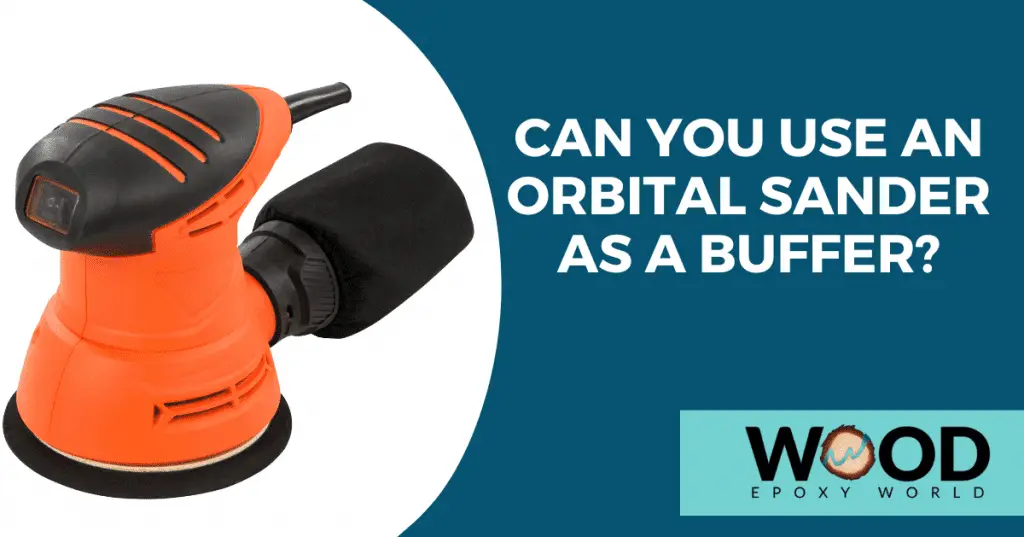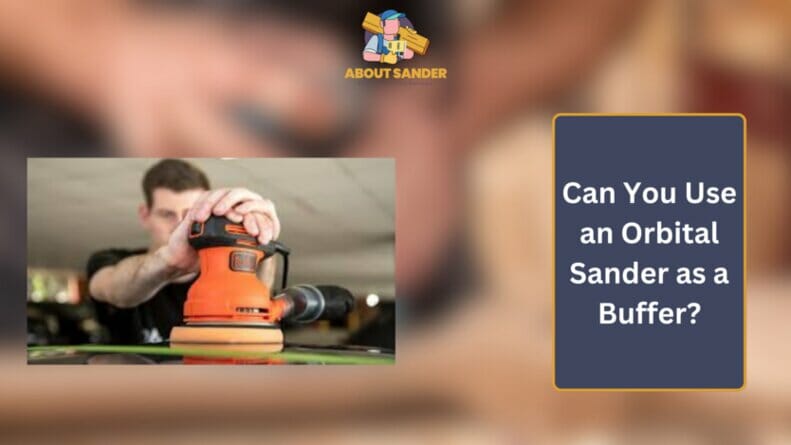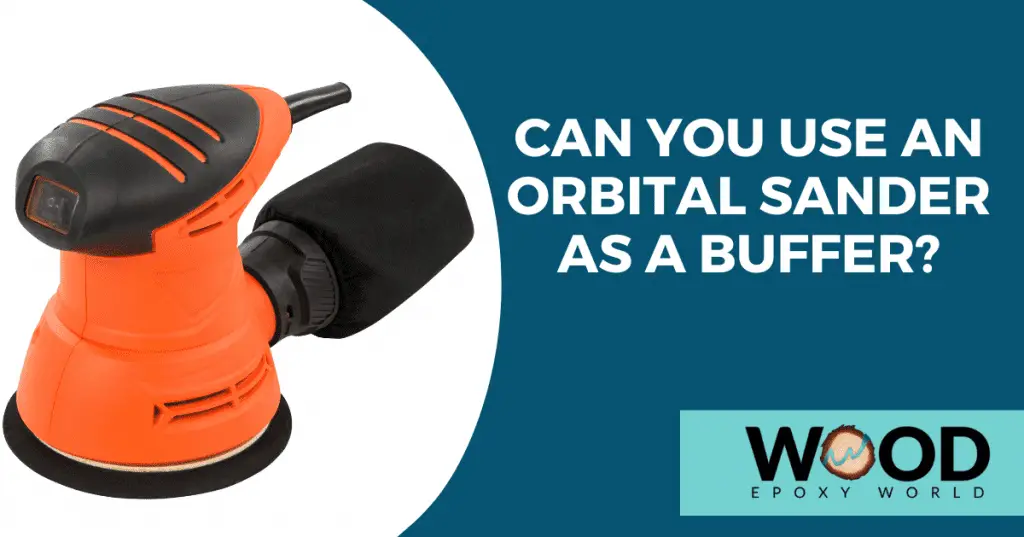If you’ve ever wondered if you can use a random orbital sander as a buffer, you’re not alone. Many DIY enthusiasts and home improvement enthusiasts have pondered this question. In this article, we’ll explore whether or not a random orbital sander can serve as an effective buffer for your projects. So, let’s dive in and find out the answer!
When it comes to sanding and buffing, it’s essential to have the right tools for the job. A random orbital sander is an excellent tool for removing material and creating a smooth finish. But can it also work as a buffer? We’ll examine the features and limitations of a random orbital sander to determine if it can serve this dual purpose.
Imagine if you could save time and money by using just one tool for both sanding and buffing. It sounds like a dream come true! But is it feasible? Stick around as we uncover the truth about using a random orbital sander as a buffer.
Do you want to know if you can use a random orbital sander as a buffer? While they have some similar functions, it’s not recommended to use a random orbital sander as a buffer. There are key differences between the two tools, including speed and motion. Buffers provide a smoother, even finish, while orbital sanders are better suited for removing material. It’s best to use the right tool for the job to achieve the desired results.

Can You Use a Random Orbital Sander as a Buffer?
If you’re into DIY projects or work in the field of woodworking, you’ve probably come across the term “random orbital sander.” These power tools are known for their ability to quickly and effectively smooth surfaces. But have you ever wondered if you can also use a random orbital sander as a buffer? In this article, we’ll explore the possibilities and limitations of using a random orbital sander as a buffer, and whether it’s a viable alternative for achieving that glossy, polished finish.
Understanding the Difference: Random Orbital Sander vs. Buffer
Before diving into whether you can use a random orbital sander as a buffer, it’s essential to understand the differences between the two tools. A random orbital sander is designed to sand wood, metal, or other materials by sanding in small, circular patterns. It’s equipped with a sanding pad that moves in an elliptical or random motion, minimizing the risk of swirl marks or scratches on the surface. On the other hand, a buffer, also known as a polishing machine, is specifically designed for achieving a smooth, glossy finish. It uses a circular motion to apply a polishing compound to the surface, effectively removing imperfections and enhancing shine.
While both tools have similarities in terms of their circular motions, the main difference lies in the purpose they serve. A random orbital sander is meant to remove material and smooth surfaces, while a buffer is used for polishing and enhancing shine. Now, let’s explore the possibilities and limitations of using a random orbital sander as a buffer.
Can a Random Orbital Sander Be Used as a Buffer?
Many DIY enthusiasts wonder if they can save money and achieve a polished finish by using their random orbital sander as a buffer. While it may seem tempting, it’s important to know that a random orbital sander is not specifically designed for polishing purposes. The design and mechanics of a random orbital sander make it less suitable for achieving the desired results of a buffer.
One of the main limitations is the speed at which a random orbital sander operates. Orbital sanders typically have higher RPM (rotations per minute) compared to buffers. The high-speed sanding action can result in excessive heat generation, which can potentially damage the surface or the polishing pad. Additionally, the aggressive sanding motion of a random orbital sander may not provide the fine control needed for precise polishing. Buffer machines, on the other hand, have variable speed settings and are specifically designed for lower RPMs, allowing for careful and controlled buffing.
Moreover, buffers often come with features such as adjustable handles and specialized pads that allow for increased maneuverability and ease of use. These features are absent in a random orbital sander, making it less ergonomic and more difficult to achieve the desired polished finish.
Alternative Options: Buffering Attachments and Hand Polishing
If you’re determined to find a solution that allows you to achieve a polished finish without investing in a separate buffer, there are a couple of alternative options available. Some random orbital sanders come with buffering attachments or accessories that can be attached to the sanding pad. These attachments are designed to convert the sander into a buffer by allowing you to attach a polishing pad. While this may provide some level of polishing, it’s important to note that the performance may still fall short compared to a dedicated buffer machine.
Another alternative is hand polishing. This involves using polishing compounds and pads by hand to achieve a glossy finish. While it may be more time-consuming and physically demanding compared to using a machine, it can still yield satisfactory results. Hand polishing allows for greater control and precision, especially when dealing with delicate or intricate surfaces.
However, it’s important to keep in mind that hand polishing may not be practical for larger projects or when dealing with tougher materials. In such cases, investing in a dedicated buffer machine would yield better and more efficient results.
The Benefits of Using a Dedicated Buffer
While it may be tempting to use a random orbital sander as a buffer for the sake of convenience or cost-saving, it’s important to highlight the benefits of using a dedicated buffer machine:
- Specialized design: Buffer machines are specifically engineered to achieve the desired polishing results. They come with features such as adjustable speed settings, ergonomic handles, and specialized polishing pads that maximize efficiency and ease of use.
- Controlled polishing: Buffers offer a greater level of control, allowing for precise and uniform polishing. The variable speed settings enable users to adjust the speed according to the type of surface being polished.
- Faster results: Buffers are designed to work efficiently and quickly, allowing for faster completion of polishing projects compared to using alternative methods.
- Professional-grade results: By using a dedicated buffer machine, you can achieve professional-grade results with a smooth, glossy finish that enhances the appearance of the surface.
- Reduced risk of damage: Buffer machines operate at lower RPMs compared to random orbital sanders, reducing the risk of heat generation or damage to the surface being polished.
Overall, investing in a dedicated buffer machine is highly recommended for obtaining the best possible results when it comes to polishing and achieving a glossy finish.
Tips for Using a Buffer Machine
If you decide to invest in a dedicated buffer machine, here are some tips to ensure optimal performance and results:
- Always start with a clean and dust-free surface before using the buffer machine.
- Use the appropriate polishing pad and polishing compound for the type of surface you’re working on.
- Apply consistent pressure and keep the buffer machine moving in circular motions for an even finish.
- Start with a low speed and gradually increase it as needed, based on the type of material and desired results.
- Regularly inspect the polishing pad for any signs of wear or clogging and replace it if necessary.
- Work in small sections to ensure that each area receives sufficient attention and polishing.
- Follow the manufacturer’s instructions and guidelines for proper usage and maintenance of the buffer machine.
Conclusion
While it may be tempting to use a random orbital sander as a buffer, it’s important to understand the limitations and potential risks involved. A random orbital sander is not specifically designed for polishing purposes, and using it as a buffer may result in less than satisfactory results or even damage to the surface. Investing in a dedicated buffer machine is the best option for achieving professional-grade results with a smooth, glossy finish. However, if you’re working on smaller projects or prefer hand polishing, alternative options such as buffering attachments or hand polishing can be considered. Whichever method you choose, always prioritize safety and follow the manufacturer’s guidelines to ensure optimal performance and the best possible results.
Key Takeaways: Can You Use a Random Orbital Sander as a Buffer?
- Using a random orbital sander as a buffer is possible, but not recommended.
- A random orbital sander is designed for aggressive sanding, while a buffer is used for polishing and finishing.
- Using a sander as a buffer can result in damage to the surface and inconsistent polishing.
- A buffer has a slower speed and is specifically designed for creating a high gloss finish.
- It’s best to use the right tool for the job to achieve the desired results.
Frequently Asked Questions
Welcome to our FAQs section, where we answer some common questions about using a random orbital sander as a buffer. Whether you’re a newbie or an experienced DIYer, we’ve got you covered with some helpful insights!
Can I use a random orbital sander as a buffer for my car?
While you technically can use a random orbital sander as a buffer for your car, it’s not recommended. Random orbital sanders are primarily designed for smoothing surfaces and removing material. Buffing requires a different tool specifically designed for the task. Using a buffer is a safer option as it minimizes the risk of damaging your car’s paintwork. Buffing machines have the appropriate speed settings and pads that are gentle on the surface, providing a better finish with less effort. So, to achieve the best results without risking any damage, it’s best to invest in a dedicated car buffer.
However, if you’re in a pinch and don’t have access to a dedicated buffer, you can take some precautionary measures if you decide to use a random orbital sander. First, make sure to use a foam polishing pad instead of a sanding pad. Foam pads are more forgiving and less likely to leave swirl marks or scratches. Second, use the lowest speed setting and be extra cautious while working. Always keep the sander moving to avoid dwelling in one spot for too long. Remember, using a proper car buffer will give you the best results and peace of mind!
Is it safe to use a random orbital sander as a furniture buffer?
Yes, you can use a random orbital sander as a buffer for furniture, but with certain considerations. Random orbital sanders are versatile tools that can be used for sanding and buffing tasks. However, when using it as a buffer, there are a few things to keep in mind to ensure safety and achieve the best results. First, make sure to use the appropriate attachment for buffing. Typically, a foam or felt pad is used for furniture buffing to achieve a smooth and glossy finish. Avoid using a sandpaper attachment meant for sanding as it may damage the furniture’s surface.
Second, adjust the speed setting on the sander. When buffing furniture, it’s best to use a lower speed setting to avoid generating excessive heat or causing damage. Always test the speed and pressure on a small, inconspicuous area before proceeding with the entire surface. Third, be mindful of your technique. Keep the sander moving at all times and maintain a consistent pressure to avoid creating swirl marks. By following these guidelines, you can safely and effectively use a random orbital sander as a buffer for your furniture projects.
Can a random orbital sander be used as a floor buffer?
No, it’s not recommended to use a random orbital sander as a floor buffer. Random orbital sanders are designed for tasks like sanding and finishing surfaces, but they are not suitable for buffing large floor areas. Buffing floors requires a specialized floor buffer or a machine designed specifically for that purpose. Floor buffers have a higher rotating speed than random orbital sanders, allowing them to effectively polish and buff the floor surface. They also have larger pads that cover more area, making the process more efficient.
Using a random orbital sander on the floor can be challenging and time-consuming. The small pad size and slower speed of a random orbital sander would make the process of buffing a floor quite tedious. Additionally, the sanding motion of the random orbital sander may not provide the desired results when it comes to floor buffing. To achieve the best outcome and save yourself from unnecessary hassle, it’s best to invest in or rent a floor buffer specifically designed for the job.
Can you use a random orbital sander as a shoe buffer?
While a random orbital sander can technically be used as a shoe buffer, it is not the ideal tool. Random orbital sanders are primarily designed for woodworking and other surface finishing tasks, and using them on your shoes might not yield the desired results. Shoe buffers, on the other hand, are specifically designed to polish and shine shoes, providing a glossy finish.
If you’re in a bind and don’t have access to a shoe buffer, you can try using a random orbital sander with caution. First, make sure to use a soft polishing pad or a lambswool bonnet attachment. These attachments are gentler on the shoe material and less likely to cause any damage. Second, use the lowest speed setting on the sander to minimize the risk of abrasion or burnishing. Lastly, keep the sander moving and apply light pressure to avoid any unwanted scratches or marks. However, for the best results and to prolong the life of your shoes, investing in a proper shoe buffer is recommended.
Can a random orbital sander be used as a metal buffer?
While a random orbital sander can be used for metal surfaces, it is not the ideal tool for metal buffering. Random orbital sanders are primarily designed for smoothing surfaces and removing material, making them more suited for tasks like woodworking. When it comes to metal buffering, there are better tools specifically designed for the task.
If you need to buff metal surfaces, it’s recommended to use a dedicated metal buffer or a polisher designed for metal applications. These tools provide the control, speed, and power needed to achieve a smooth and shiny finish. They often come with specialized attachments and pads that are more suitable for metal buffing. Using a random orbital sander on metal surfaces may not yield the desired results and can potentially damage the metal or leave visible marks. So, to ensure the best outcome and protect your metal surfaces, it’s best to invest in the right tool for the job.

Summary
So, can you use a random orbital sander as a buffer? While they might look similar, these tools have different purposes. A random orbital sander is great for sanding surfaces, while a buffer is specifically designed to polish and give a shiny finish. So, if you want a smooth and glossy result, it’s best to use a dedicated buffer.
Using a random orbital sander as a buffer might not give you the desired outcome. Buffers have a different motion that helps distribute polish evenly, while sanders can leave swirl marks or streaks. It’s always better to use the right tool for the job to achieve the best results and avoid any unnecessary damage to your workpiece.
